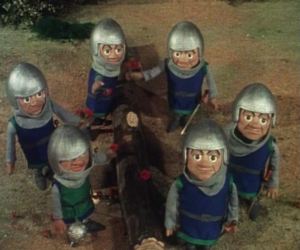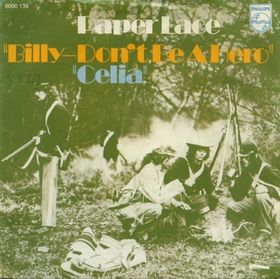

Hi there and welcome to Ado's Blog. I am obsessed with nostalgia, especially 1960s & 1970s nostalgia and I enjoy nothing more than reflecting on days and times that have sadly long since gone! So join me, as I take a nostalgic gander down Memory Lane and celebrate all things past and occasional present, both good and bad! (All images used that are copyrighted are copyrighted to their respective publishers and are only used here for review purposes.)
Tuesday, 10 May 2011
Radio Times - Sir Norman Wisdom: 1956

Cloppa Castle - Episode One: Spring Is Sprung









Paper Lace - Billy don't be a Hero: 1974

"Billy Don't Be A Hero" is a 1974 anti - war song by Paper Lace and was also recorded by Bo Donaldson and the Heywoods. It was written by Mitch Murray and Peter Callender.
Because the song was released in 1974, it is often associated with the Vietnam War, though it actually refers to the American Civil War as evidenced by the "soldier blues" (the Union Forces) in the lyrics and on the cover of the single album. Also, A 1974 music video shows the band performing in Union uniforms. A young woman is distraught that her fiancé chooses to leave the area with an Army contingent passing through the town and go with them to fight. She laments,
- "Billy, don't be a hero! Don't be a fool with your life!
- "Billy, don't be a hero! Come back and make me your wife!
- "And as Billy started to go, she said, 'Keep your pretty head low!'
- "Billy, don't be a hero! Come back to me!"
The song goes on to describe how Billy is killed in action in a pitched battle after volunteering to ride out and seek reinforcements. In the end, the woman throws away the regret letter notifying her of Billy's "heroic" death.
Paper Lace's version of "Billy Don't Be a Hero" hit number one on the UK singles' chart on March 16 1974. The band made plans to release it in America but the song was covered and released by Bo Donaldson and the Heywoods. Their version was rushed out before Paper Lace could release and it hit no 1 on the Billboard Hot 100. on June 15. Subsequently although Paper Lace had the chart-topper in the UK, its version stalled at #96 on the Billboard Hot 100. The Bo Donaldson version failed to chart at all in the UK.
Classic Bond - Thunderball: 1965

The phenomenal success of Goldfinger (d. Guy Hamilton, 1964) and the global appetite for greater spectacle and increased fantasy clearly indicated the way forward for the 007 franchise. "Here comes the Biggest Bond of All!" screamed the posters for Thunderball (1965), confirmingEon's new approach. At its most obvious, this was signalled by the movie's huge $5.5million budget and the fact it was the first to be filmed in Panavision widescreen.
More significantly, however, Thunderball departed from the tight narrative structures typified by its predecessors and introduced a more episodic format, in which sprawling action sequences are included for visual effect as opposed to plot advancement.

The most obvious example remains the vast, climactic battle, shot by underwater expert Lamar Boren and employing 45 scuba divers as extras. Director Terence Young clearly felt he was out of his depth shooting these scenes: "all that underwater stuff was anti-James Bond," he later commented, "Because it was slow motion". However, inventive choreography and John Barry's relentless score help rescue the sequences, and aqua-action became a staple of the series.

Thunderball also ushered in the voluptuous villainess who cannot be turned by Bond's sexual and ideological persuasiveness. Domino, played by former Miss France Claudine Auger, exemplifies the archetypal submissive 'Bond girl', but Fiona Volpe (Luciana Paluzzi) - a strong, intelligent enemy agent - created the template for tough, independent females which still endures.

Ken Adam's sets represent another triumph. SPECTRE's cold, gleaming, ultra-modern boardroom, for example, contrasts wonderfully with the Secret Service's conference chamber, a marble and mahogany vision of traditional Colonialism. The juxtaposition quietly implies that the older, more British virtues remain the most reassuring and legitimate.

Although less taut than the opening three Bond movies, Thunderball offers enough to recommend it. John Stears's Oscar-winning visual effects, Ted Moore's lush photography and the spectacular sets all conspire to make this a visually arresting piece of work. Connery's cool, charismatic Bond remains compelling, and he clearly enjoyed working with Young again, who allowed him to improvise many of the film's trademark one-liners.

This was more extravagant and less realistic than previous Bonds, and its takings were unsurpassed until The Spy Who Loved Me (d. Lewis Gilbert, 1977). Producer Albert R. Broccoli in particular noted the correlation between cinematic excess and success, and resolved to replicate the formula. As Bond mutters after harpooning the evil Vargas (Philip Locke), "I think he got the point."
MONTHLY FILM BULLETIN
THE BRITISH FILM INSTITUTE
Volume 33, No.385, February 1966, page 20
THUNDERBALL (1965)
SPECTRE, the International Crime Syndicate, plans to hijack two atomic bombs from NATO, promising Whitehall not to wipe out two cities so long as a ransom of £100 million is paid. The signal for Whitehall's acceptance is that Big Ben should strike seven at six o'clock. The operations are begun at a health clinic near the NATO airfield, when Count Lippe tries to kill Agent 007, James Bond, on an exercising machine. Bond is rescued by therapist Patricia, and retaliates by stepping up the heat in Lippe's steam bath. Meanwhile Fiona, of SPECTRE, suborns Major Derval, of NATO, and has him murdered by a bandaged man at the clinic. The bandages cover the results of plastic surgery: SPECTRE man Palazzi has become his victim's double. Palazzi now flies off with the bombs in a plane which sinks to the ocean floor. He is in turn murdered by SPECTRE executive Largo, who takes the bombs in a submarine to a secret underwater cave. Despatched to Nassau, Bond meets Derval's sister, Domino, who is living with Largo. After losing to Bond at chemin defer, Largo invites him to Palmyra, his secluded palatial estate. Bond falls into Largo's steel-lidded, shark-infested swimming pool, but escapes. He returns to his hotel to find Fiona in his bath-tub. They make love, after which Fiona betrays him to Largo's men. Though shot in the leg, Bond makes a getaway under cover of a local carnival. Fiona follows the trail of blood to a crowded dance floor, where Bond dances with her before manoeuvring her into the path of a bullet meant for him. With the help of Domino, who is shocked to learn that Largo killed her brother, Bond manages to locate the bombs and eliminate Largo and his army of frogmen.
Of course one would rather have Dr. Mabuse. Of course Thunderball is a blatant parody of the genre, all gargantuan sets, paintbox blood, sexless blondes and gadgetry. There is absolutely nothing memorable about it. It is simply there for the moment, to be superficially enjoyed if one likes that kind of thing, and if one can condone the vast cost of such a toyshop trifle. What does it offer?
More polish than usual, for one thing. Terence Young's direction is nothing if not taut, whisking the narrative along with the speed and precision of a jet plane, defying one to express boredom. To achieve this, he has wisely thrown away most of Bond's character detail, the drinks-and-cars expertise, and stripped Bond down to a kinky-looking Superman in red rubber, an outline Sean Connery fills for once admirably and with ease. The gadgets are splendid - hydrofoil, radio-active pill, underwater jet-harness, a health-clinic rack which threatens to rattle Bond's bones to pulp, a black-leather motor-cyclist whose machine fires rockets and who turns out under her crash-helmet to be the delectably treacherous Luciana Paluzzi.
John Hopkins has been brought in on the screenplay to provide some insolent, amatory wit; the post-Strangelove sets are by Ken Adam; Ivan Tors has provided some eerily effective underwater sequences, including a long climactic battle which looks like Agincourt fought with submarines instead of horses. In other words the film is all of a piece, cunning, heartless, extravagant, shamelessly mid-Sixties. Agreed that Adolfo Celi's villain, though perfectly adequate, is no Dr. Mabuse. But then a film like this would be enough to shock the good Doctor back to sanity.
The Monthly Film Bulletin was published by the British Film Institute between 1934 and 1991. Initially aimed at distributors and exhibitors as well as filmgoers, it carried reviews and details of all UK film releases. In 1991, the Bulletin was absorbed by Sight and Sound magazine.
Vintage Magazine Covers - January 1976 (Part One)
![Rita Hayworth - Siete Dias Ilustrados Magazine [Argentina] (1976)](http://s11.bdbphotos.com/images/orig/p/h/ph9k6j8plaotpt9l.jpg)
![Elvis Presley - TV and Movie Screen Magazine [United States] (January 1976)](http://s11.bdbphotos.com/images/orig/b/x/bxadq2xoqb4uxbdb.jpg)
![Liza Minnelli - Modern Screen Magazine [United States] (January 1976)](http://s11.bdbphotos.com/images/orig/f/5/f5dijrvyc5cqyv5i.jpg)
![Elton John - Photoplay Magazine [United States] (January 1976)](http://s11.bdbphotos.com/images/orig/x/9/x9ymws3ryxfoxoyy.jpg)
![Liza Minnelli - Films Illustrated Magazine [United Kingdom] (January 1976)](http://s11.bdbphotos.com/images/orig/5/1/51o4u4mgo4se4ug1.jpg)
![Cher - Movie Mirror Magazine [United States] (January 1976)](http://s11.bdbphotos.com/images/orig/t/9/t9dass96fhmnf6ms.jpg)
![Sean Connery - Film Comment Magazine [United States] (January 1976)](http://s11.bdbphotos.com/images/orig/k/m/kmps3uocb49voubp.jpg)
